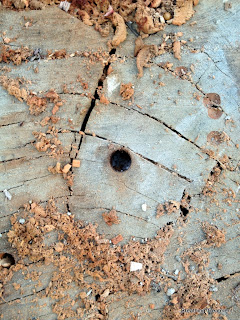I'm digging out a large Brazilian Pepper, and it feels like victory.
Part of my side yard grade improvement extends into my back yard where I had a huge Brazilian Pepper tree cut down about a year ago. (Note: What goes for Ficus also goes for Brazilian Peppers: Just don't plant them in S. California.) The rather large stump remains firmly in place as well as all its roots, sprouts and progeny, and now I have to dig the ones that have shrugged off the minor insult of being cut off at the ground. I knew they would do this, but hoped that last year's application of herbicide to some of the freshly cut stumps would make my burden lighter: It wasn't 100% effective. Last year I didn't get the opportunity to dig these out because of more pressing matters. At least with gardening you know it will always wait for you -- so long as you have time that's measured in years.
I'm using a shovel and an axe and basically double digging the entire hillside with occasional pauses to dig deeper to remove roots and rubble such as the piece of concrete left by workers in the days before I owned the property (seen in the foreground above). That root to the left of the shovel must be 7 or 8" in diameter.
End of Day 1:
The tree trunk at left (several feet in diameter) may not be amenable to axe alone but a gas line runs underneath it so stump grinders and fire are out. I'll cut all the water sprouts and as many roots as I can to deny it energy if nothing else. Acid or poison seem like good choices here.
You know what else I found buried at the base of this little hill where it joins the concrete patio? An old drain line. Apparently the drainage issue in the side yard that I am now trying to address is old news since the drain line appears to date far back in time. It appears to have drained down the back slope to the neighbor's. Of course it is non-functional now, having been broken in several different ways over the years.
In succeeding days I spent more time on this project, locating the gas pipe that runs underneath the large stump, clearing shoots and sprouts from the nearby back yard hill, and doing some more digging on the biggest stump. This is not just gardening - it's also my outdoor gym. Progress appears minor in the following photos, taken on 23 Oct, but the number of hours on the job is significant.
I'll never be able to get the main stump out without mechanical or chemical assistance, so I've drilled multiple holes and filled them with potassium nitrate (Grant's Stump Remover) and water. Apparently this promotes decomposition of the wood. Your forefathers would have used fire, a team of horses, or dynamite to take out the stump. Sadly, I can do none of those. I couldn't even get my drill bit out of one hole. Remind me about chip clearance another time.
A few days later:
I've given the sledge hammer and splitting wedges a shot at the stump, with no luck (see them lying on the stump). I sure can't make a dent in the main body of it with the axe alone. The wedges might still be useful at prying intergrown roots apart. Most of the work has been axe and shovel, but I used a saw for a bit. After this bit of work, the end seems in sight.
More later.






Props for taking on the evil Brazilian pepper. It must have an exhausting chore indeed to make American lager palatable! At my office the grounds crew let one get established on a green roof with almost no soil, and the thing has been coming up from roots, long after it was cut down to what looked like nothing. It looks like you've done a better job removing yours...
ReplyDeleteGreat post! Great snapshots of the scene too. The roots are nearly popping out of the earth!
ReplyDelete-Asheville Tree Service